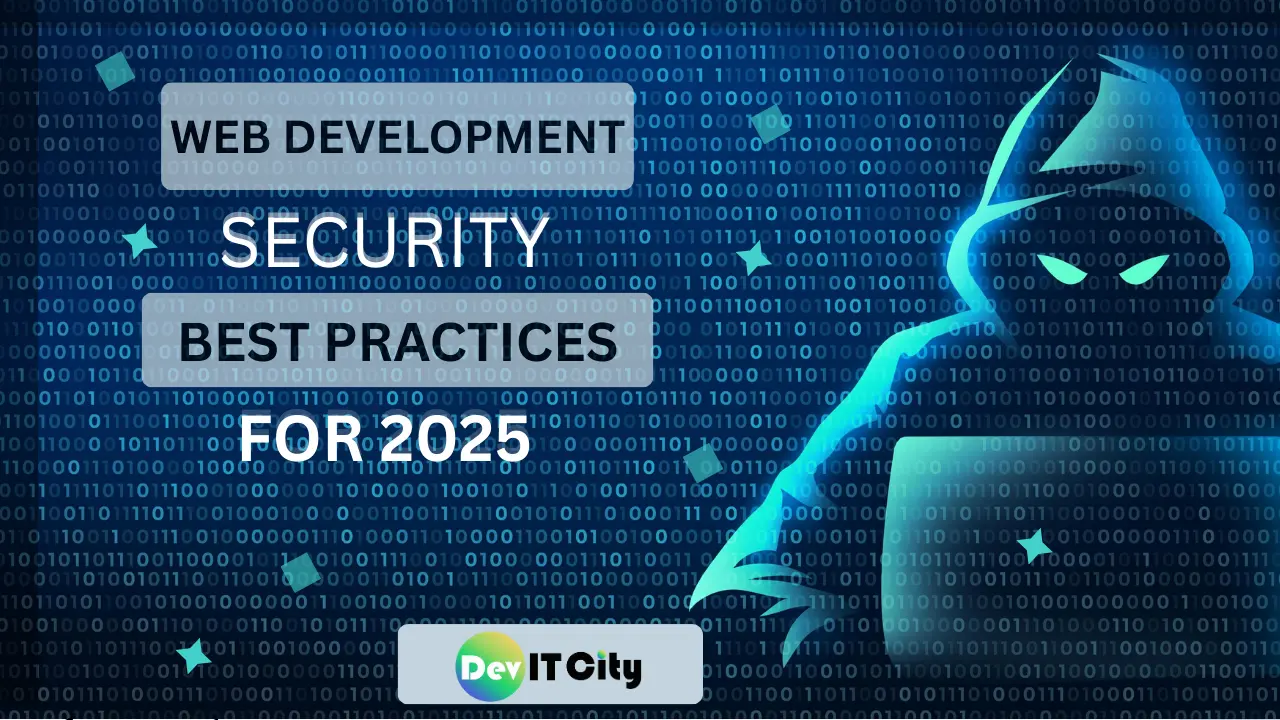By Junaid Imdad, Blogger & Digital Experience Strategist.
Let’s face it, Web Development Security used to be something many developers and site owners, myself included, didn’t prioritize. Often, security concerns only popped up after a site was built or, even worse, after it had already been compromised. But fast forward to 2025, and the landscape has changed dramatically. Security is now a fundamental aspect of the development process, not just an optional extra. Cybersecurity has become absolutely crucial.
As cyber threats evolve at breakneck speed, Web Development Security has risen to the top of the priority list for developers and business owners alike. It’s no longer just a nice-to-have; it’s the foundation of every digital experience. Whether you’re running a blog, an e-commerce site, or a SaaS platform, each one is a potential target for savvy cybercriminals. Hackers are getting better at spotting and exploiting weaknesses in websites, which makes taking proactive security measures more important than ever.
In this post, I’ll highlight some of the significant cybersecurity risks that websites will face in 2025, and more importantly, I’ll share how you can bolster your Web Development Security to safeguard your digital assets. As threats become more sophisticated, grasping and applying robust security practices isn’t just a choice anymore; it’s vital for maintaining user trust and achieving online success.
If you want to get info about how much it will cost to build an app, simply click on the link.
The Cyber Threat Landscape in 2025
Before we jump into solutions, it’s really important to grasp the risks at hand. In 2025, Web Development Security has become more critical than ever, as cyber threats are constantly evolving in both complexity and scale. The stakes are incredibly high—data breaches, ransomware attacks, and zero-day exploits can disrupt operations, erode brand trust, and lead to significant financial losses.
Having worked closely with developers and digital strategists, I’ve witnessed how even small oversights—like an outdated plugin or weak API authentication—can create serious vulnerabilities. The web environment today is fast-paced and interconnected, meaning threats can come from unexpected sources, including third-party tools, AI integrations, and even user-generated content. So, let’s take a look at some of the major cybersecurity threats that are giving developers and digital teams a real headache in 2025:
1. AI-Powered Attacks
Artificial intelligence is not just helping businesses automate workflows; it’s also being leveraged by cybercriminals to launch attacks against vulnerable targets. 2025 will witness AI-powered bots capable of automatically detecting vulnerabilities, cracking weak passwords or even mimicking legitimate user behavior to bypass security systems.
Some bots even scour thousands of websites to detect outdated plugins, unpatched frameworks and exposed admin panels.

2. Zero-Day Exploits
Zero-day vulnerabilities have always been a significant concern, but in 2025, they’ve turned into a full-blown nightmare for anyone working in web development and cybersecurity. The landscape has shifted dramatically—AI-powered detection tools are uncovering flaws faster than ever, while dark web marketplaces are booming with immediate access to newly found exploits. What used to take weeks or even months to weaponize can now be transformed into an active attack vector in just a matter of hours.
This creates an incredibly narrow window for response. Developers and security teams need to be proactive rather than reactive. Relying on a monthly update cycle or thinking your current defenses are “good enough” just won’t cut it anymore. It only takes one overlooked patch or an outdated plugin to put sensitive customer data at risk, disrupt services, and tarnish your brand’s reputation.
No matter how cutting-edge your tech stack is—be it React, Next.js, Laravel, or anything else—it’s all for nothing if your systems aren’t patched and monitored in real time. The most sophisticated code won’t shield you if the underlying infrastructure is vulnerable.
To stay secure in 2025, you need to embrace a mindset of continuous vigilance. This means setting up real-time security monitoring, automating patch deployments, conducting regular code audits, and keeping up with the latest threat intelligence. In a world where exploits spread at the speed of AI, being informed and responsive isn’t just a good idea—it’s absolutely essential.
3. Credential Stuffing and Password Cracking
In recent years, we’ve seen a surge in data breaches from major platforms, leading to millions of stolen login credentials making their way onto the dark web. This has created a perfect breeding ground for a growing threat known as credential stuffing. Unlike the more traditional brute-force attacks, credential stuffing is alarmingly efficient—cybercriminals deploy bots to test out stolen username and password combinations across a multitude of websites, banking on the fact that many users tend to reuse their credentials.
This situation poses a significant risk to Web Development Security in 2025, particularly for smaller businesses that might think they’re flying under the radar of attackers. The truth is, automated scripts don’t play favorites. If your site has a login form, you could very well be a target.
Without proper safeguards—like multi-factor authentication (MFA), rate-limiting, IP throttling, CAPTCHA challenges, and behavioral analysis tools—even a simple blog or e-commerce site can easily fall victim. Once attackers breach your defenses, they can exploit user accounts for financial gain, distribute spam, exfiltrate data, or even worse.
Credential stuffing attacks can be tricky to spot with traditional logging methods since they often mimic normal user behavior. That’s why it’s crucial for developers to implement layered security measures and remain vigilant. Prevention has evolved from being just a technical necessity to becoming a fundamental responsibility to safeguard your users’ trust and data.
Many people still reuse passwords, which puts their accounts at risk and could give attackers an easy way in.
4. Ransomware Targeting Web Servers
Ransomware attacks are no longer just a concern for big corporations—2025 has seen a significant uptick in small business websites being targeted, often with devastating effects. Cybercriminals are now using automated tools to take advantage of vulnerabilities in outdated plugins, unsecured admin panels, and unpatched CMS platforms. Once they gain access, they encrypt vital files and lock owners out of their own sites, demanding cryptocurrency payments for their return.
What’s particularly concerning is that many small businesses don’t have recent, secure backups, leaving them with a tough decision: pay the ransom or risk losing everything. This shift in focus from large enterprises to everyday businesses means that no website is too small or insignificant to be attacked.
To safeguard themselves, small business owners need to adopt a mindset similar to that of larger enterprises when it comes to Web Development Security. This includes:
- Regularly backing up website data to secure, off-site locations
- Keeping all software, themes, and plugins up to date
- Implementing strong access controls and firewalls
- Monitoring file integrity and suspicious login attempts
- Investing in malware detection tools and ransomware protection plugins
Ransomware doesn’t discriminate—thinking you’re safe just because your business is small can be a costly oversight. In 2025, being proactive and prepared isn’t just a good idea; it’s absolutely essential.
5. Cross-Site Scripting (XSS) & Injection Attacks
Traditional web vulnerabilities like Cross-Site Scripting (XSS), SQL Injection, and Command Injection are still major threats in 2025. As web applications evolve to include real-time content, API integrations, and third-party scripts, their attack surface grows significantly. These attacks take advantage of weak input handling and inadequate validation, which can result in data breaches, unauthorized access, or even total site takeovers. It’s more important than ever to bolster web development security through practices like input sanitization, secure coding, and regular vulnerability scanning to fend off these threats.
6. Third-Party Plugin Vulnerabilities
When it comes to platforms like WordPress, Shopify, and even the latest headless CMS options, they all lean heavily on third-party plugins, extensions, and APIs to boost their functionality. While this can be super convenient, it also raises some serious security red flags in web development. Many plugins, especially the outdated or poorly maintained ones, can open the door to dangerous vulnerabilities. Even if your main CMS is rock solid, just one compromised plugin could allow hackers to sneak into your site’s backend. To keep your digital presence secure in 2025, it’s crucial to stay on top of regular updates, conduct code reviews, and stick to trusted sources.

How to Protect Your Website in 2025
Let’s dive right in: What can you do to safeguard your website in 2025?
Over the years, I’ve put together a solid list of practical strategies that every developer and site owner should adopt this year. These features aren’t just optional extras; they’re absolutely essential for ensuring Web Development Security. From enforcing HTTPS and implementing real-time threat detection to conducting regular code audits and using secure user authentication methods, the current web environment requires us to take proactive security steps at every phase of development. Overlooking these fundamentals could put both your users and your business at unnecessary risk.
1. Prioritize Secure Coding Practices
Although it might sound obvious, many developers still neglect secure coding practices. Always heed these practices:
- Sanitize and validate all user input.
- Utilise parameterized queries to avoid SQL injection attacks and keep SQL injection safe.
- Avoiding XSS attacks.
- Avoid inline scripts and eval statements
Modern frameworks like Laravel, Django and Next.js offer built-in protection mechanisms – so take advantage of them.
2. Implement HTTPS Without Excuse In 2025
In 2025, HTTPS won’t just be a nice-to-have; it’ll be a must for anyone involved in web development and security. This protocol encrypts the communication between your users and your server, keeping sensitive information safe from prying eyes, tampering, or theft by malicious actors. Whether you’re running an online store, a personal blog, or a SaaS platform, securing your site with HTTPS is absolutely essential. Make sure to invest in a reliable SSL certificate (or take advantage of free options like Let’s Encrypt) and enforce HTTPS throughout your entire website to foster trust and safeguard user data.
3. Implement Web Application Firewalls (WAFs)
A Web Application Firewall (WAF) plays a vital role in the security of modern web development. Think of it as a gatekeeper that filters and monitors HTTP traffic between your web application and the internet, stopping harmful requests before they can reach your server. Services like Cloudflare, Sucuri, and AWS WAF provide robust protection by identifying suspicious activities, defending against DDoS attacks, limiting bot traffic, and protecting your app from known vulnerabilities and exploits. In 2025, having a WAF isn’t just a smart move; it’s absolutely essential for keeping your online presence secure.
4. Enable Multi-Factor Authentication (MFA)
Multi-Factor Authentication (MFA) plays a vital role in securing web development, especially as password breaches become increasingly frequent. By adding an extra layer of security to traditional login methods, MFA prompts users to confirm their identity through an additional step, like entering an SMS code, verifying via email, or using an authenticator app. This significantly lowers the chances of unauthorized access, even if someone manages to get hold of a password. By 2025, adopting MFA won’t just be a good idea; it will be a standard practice for safeguarding user accounts and sensitive information.
5. Keep Everything Updated
Outdated software poses one of the greatest security risks. Make sure everything stays up-to-date to protect against it:
- Update your CMS, plugins and themes regularly.
- Keep an eye out for any updates to frameworks or libraries, as patches could potentially impact them.
- Automated tools provide alerts of known vulnerabilities.
- Even one day of delay in fixing an important issue could leave your site at risk.
6. Conduct Regular Security Audits
It’s a smart move to regularly run security scans on devices, and there are some great tools to help with that. For instance, OWASP ZAP and Nikto are excellent for checking the security of web applications, while WPScan is specifically designed for scanning WordPress sites. Acunetix goes a step further by identifying vulnerabilities in your code, spotting outdated software, and checking for any open ports or misconfigurations on your servers.
7. Stay Safe by Backing Up Regularly
In today’s world, where ransomware attacks and data breaches are becoming more common, having backups is absolutely essential for Web Development Security. It’s not enough to just create backups anymore; you need to make sure they’re automatic, encrypted, and stored safely offsite or in the cloud. Equally important is the need to regularly test your restoration process. A backup that can’t be quickly restored during a crisis is pretty much useless. For developers and site owners in 2025, having a solid backup strategy isn’t just a precaution—it’s your digital lifeline.
8. Choose Secure Hosting Providers
Low-cost hosting could cost more in the long run. Select a provider who provides:
- Regular security monitoring of property.
- DDoS Protection with auto updates and patch management
- Provide separate hosting environments for multi-site hosting environments
- Reputable hosts also provide invaluable logs in the event of an attack.
9. Limit User Roles and Access
Not every team member requires administrative access. In 2025, we employ the principle of least privilege; thus granting users only those permissions necessary for them to complete their task successfully.
Regularly audit user accounts and remove obsolete or inactive users.
10. Educate Your Team (and Yourself)
Even in 2025, human error still stands as the biggest vulnerability in Web Development Security. No amount of firewalls or encryption can save you if someone on your team accidentally clicks on a harmful link or gets duped by a well-crafted phishing scam. In fact, many of the most serious data breaches start with just one careless click. Cyber attackers are constantly honing their social engineering tactics, tricking users into making choices that jeopardize the integrity of your website.
To strengthen your Web Development Security efforts, make sure your team:
Are You aware of how to detect suspicious activities?
Use of password managers can prevent reusing credentials across platforms.
No tech stack can fully protect against human error unless your team is properly trained.
Final Thoughts: Design with Security at the Core
Having spent five years in the world of digital product development, I can say with certainty that Web Development Security isn’t just a concern for developers anymore. By 2025, it’s going to be a collective effort—designers, marketers, content strategists, and business owners all have crucial roles in safeguarding the digital assets they help create.
This means everything from implementing strong password policies and choosing secure plugins to educating teams about phishing threats and ensuring a secure user experience design. Web Development Security has evolved into a comprehensive discipline that impacts every aspect of a digital project.
If you want to know about UI/UX trends, simply click on it.

Cyber threats in 2025 are more sophisticated, faster-moving, and potentially more destructive than ever before. But that doesn’t mean we’re powerless. With the right approach to Web Development Security, businesses can stay ahead of these evolving threats. By investing in secure coding practices, robust security tools, regular vulnerability assessments, and ongoing awareness training, you can protect both your website and its users. In a digital landscape where attacks happen in seconds, proactive security isn’t optional—it’s essential.
And one final piece of advice?
Do not wait for an incident to begin taking security seriously by then it will already be too late!
Are you curious about your website’s security posture, or would like an easy-to-use checklist to assess its current setup? Leave a comment or reach out, I am always more than willing to assist!
Junaid Imdad, Blogger & Digital Experience Strategist




Best Free SEO Tools for Startups in 2025 - Devitcity
[…] Pro Tip: Use AWT to spot “lost backlinks.” Reach out to webmasters and request re-links—it’s one of the fastest ways to recover authority. Spot “lost backlinks” and recover them. To understand why trust matters online, see our blog on Cybersecurity 2025 Web Protection. […]